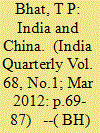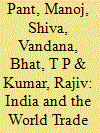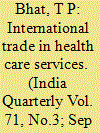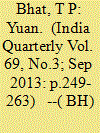| Srl | Item |
| 1 |
ID:
112420


|
|
|
|
|
| Publication |
2012.
|
| Summary/Abstract |
India and China share many similarities. In the initial years, both adopted inward-looking import substitution policies with little consideration to foreign trade. During that period, China's foreign trade policy was more regimented than that of India's. As a result, both suffered on account of inefficiency in production and technological backwardness. China's 'open door' policy came into force in 1978, and India adopted liberalisation policies much later in 1991. China's economy grew much faster with an emphasis on export growth and attracting foreign direct investment. India, too, followed this approach in a calibrated manner. Domestic economic reform in China was carried out with a view to join the World Trade Organization (WTO). Entry of China into WTO unfolded trade liberalisation on an unprecedented scale. China's foreign market access enhanced its export growth to a phenomenal level. Now it has become the number one exporter, surpassing the US. India's exports also grew, but not as fast as China's. Trade instrument deployed by both the countries varies in nature and substance. China's export competitive power is well established in the global market, while India is yet to get to that level.
|
|
|
|
|
|
|
|
|
|
|
|
|
|
|
|
| 2 |
ID:
074186


|
|
|
| 3 |
ID:
140387


|
|
|
|
|
| Summary/Abstract |
In the last two decades, international trade in health care services has expanded under the GATS. It has acquired new dimensions with the application of advanced information and communication technology and cross-border mobility. India is a participant in the GATS and has made binding commitments to minimise trade barriers. Under GATS, trade liberalisation is effected through four modes: mode 1 represents cross-border supply; mode 2, consumption abroad; mode 3, commercial presence; and mode 4, presence of natural persons. Though all modes are not totally free and are subject to restrictions, India enjoys certain distinct advantages, especially under modes 2 and 4. India has emerged as a hub for clinical research, has established superiority in IT-enabled and back-end services and has built a reputation in offering an array of specialised medical and surgical interventions at affordable prices, which have boosted medical tourism. The global health care market is highly competitive; therefore, there is a need for suitable export strategies to effectively tap into the potential of the individual markets.
|
|
|
|
|
|
|
|
|
|
|
|
|
|
|
|
| 4 |
ID:
122645


|
|
|
|
|
| Publication |
2013.
|
| Summary/Abstract |
The emergence of China as a powerhouse of the world economy has added a new dimension to the global currency market. China's impressive economic growth and phenomenal rise in exports have given considerable strength to its currency yuan in recent years. To what extent will China push to make the yuan the world's reserve currency has become a burning issue. Currently, the share of yuan in total world reserves is hardly 1 per cent. The reasons are obvious. The yuan is not fully convertible, the capital market is shallow, the exchange rate is not flexible and international acceptance of yuan as a store of value is non-existent. In the face of these constraints, China is showing an inclination to make the yuan an international currency and to rival the US dollar and euro. Increase in the inflow of foreign direct investment as well as outflow of investment abroad is enabling China to move towards internationalisation of yuan in the near future. Regionalisation of the yuan is gaining importance with rise in its international trade in Asia. China has now allowed the commercial banks in Hong Kong to accept the yuan-denominated deposits. It is further extending loans in yuan to developing countries. Many steps are being taken towards making the yuan an international reserve currency. At the outset, it appears that the yuan would become an international currency in the foreseeable future.
|
|
|
|
|
|
|
|
|
|
|
|
|
|
|
|